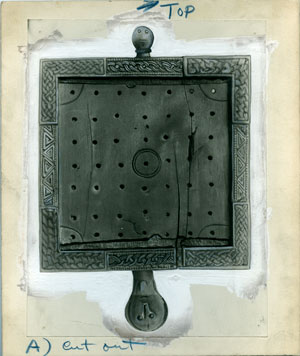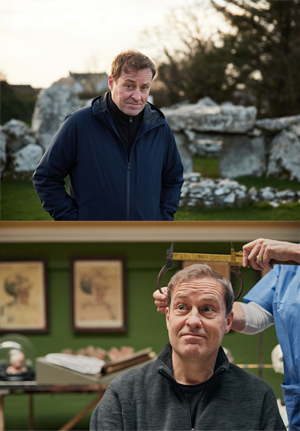ARDAL O’HANLON: TOMB RAIDER
Published in Issue 6 (November/December 2022), Reviews, Volume 30BBC1, 9 May 2022; RTÉ1, 16 May 2022
Alleycats TV
By Sylvie Kleinman

Above: The tenth-century Viking gaming-board excavated by the Harvard team in 1932 at Ballinderry crannog 1, Co. Westmeath. Adolf Mahr nevertheless described it as one of a collection of artefacts chosen to reflect the genius of the ‘old Celtic race’ in a booklet for the 1933–4 Chicago World’s Fair. (NMI)
What does it mean to be Irish, and what truth lies beneath our comforting origin tales? Pensive and awed, Ardal O’Hanlon opened this captivating documentary by pacing through a suitably misty Neolithic court tomb, an iconic example of ‘sacred sites’ connecting us to our earliest ancestors. The mood bluntly shifted as he reverted to his characteristic, facetious self: ‘Well’, he blurted out, ‘at least that’s what I’d always been told!’
If the choice of presenter and Hollywoodish title initially raised doubts among more academically minded viewers, we were swiftly hooked and willingly carried away. The film explored deeply held beliefs about the Irish, but through the ideologically charged prism of a research project led by a Harvard university team in 1932–6. The archaeological component of this Harvard Mission added greatly to national collections and contributed to advancing more systematic methods here. They triggered an archaeological frenzy, so why was this story forgotten, for so long?
Beyond their epic quest to unearth proof of the purity of Ireland’s Celtic origins, their ideology was also steeped in the suspect pseudo-science of eugenics, as Mairead Carew, author of a pioneering book on the topic, has demonstrated (‘Harvard, Celtic skulls and eugenics in de Valera’s Ireland’, HI 26.5, Sept./Oct. 2018, pp 16–18). This form of racial typing, prevalent in the 1930s, claimed to validate itself through science. Carew was interviewed but was also a consultant for this richly detailed and multi-layered film, which reconstructed the facts while deconstructing the mind-sets of the time. These sought to shape new, truly ‘national’ identities during the first decade after partition, both north and south. We would ‘experience strange science’ and uncover ‘dark’ histories, but the darkness was not about Stone Age bone-bashing nor ritual human sacrifice. Sound and image frenetically carried us through clips of tweedy types surveying digs, Irish chaps in caps at the ready with their shovels and, inevitably, Hitler shrieking from a podium.
The craniometry called for some mild humour. The Harvard team included social and physical anthropologists and, though they found no ‘long upper-lipped baboon-faced Irishmen’, O’Hanlon pottered about the old Anatomy Building in Trinity College, Dublin, peering (literally) at skeletons in cupboards. To ease the horrific implications, he aptly stared, bewildered, wide-eyed and Father-Dougally, at the camera while his skull was measured with some clunky, lethal Victorian instrument which looked repurposed from a Dyflinn flesh shamble.
In Dev’s Ireland there was a deep reverence for the past, but archaeology was in its infancy. In this golden age of intrepid explorers, tomb-raiding elsewhere, most sites in Ireland had not yet been properly excavated, if at all. Thus, not scientifically dated, and owing to the prevailing adherence to that single, defining myth, they were anointed as Celtic.
Enter a more disturbing layer, if not unexpected in these pages: Dr Adolf Mahr, the Austrian-trained archaeologist appointed Senior Keeper of Irish Antiquities at the National Museum of Ireland in 1927. The museum served as the nerve centre for the Harvard Mission, and he was their main adviser, his influence evidently enhanced by his appointment as the NMI’s Director in July 1934. By then he was also the leading Nazi in Ireland: O’Hanlon had observed that this was ‘tricky’ history.
While Mahr’s professionalism certainly contributed to that institution and Free State archaeology, some cringing viewing ensued. We travelled back to the ‘Pageant of the Celt’ at the Chicago World’s Fair (1933–4), for which he wrote a booklet on the progress in Irish archaeology, stressing that the artefacts chosen reflected the genius of the ‘old Celtic race’. These included a gaming-board unearthed by the Americans in 1932 at Ballinderry crannog 1, Co. Westmeath, though they had dated it as tenth-century Viking, since upheld. The site, according to Hugh O’Neill Hencken of Harvard, was representative of Christian Gaelic Ireland, before the English invaded.

Above top: Presenter Ardal O’Hanlon opened the documentary at the Neolithic court tomb at Creevykeel, Co. Sligo. (RTÉ). Above below: Ardal O’Hanlon has his head examined in the old Anatomy Building in Trinity College, Dublin. (RTÉ)
We began with O’Hanlon enthralled by the Creevykeel court tomb (Co. Sligo), a specific type of site which became the speciality of a compelling and far more scrupulous scholar. Emyr Estan Evans, a Welshman and a professor at Queen’s University, Belfast, rivalled Mahr as the leading archaeologist north of the border but was more precise and factual, ‘not one for romanticising the past’. In sharp contrast to Mahr’s ‘fixed notion of the ancient Irish Celt’, Evans did not indulge in ‘sentimental regrets for a Celtic twilight of doubtful authenticity’. At Aghnaskeagh (Co. Louth), against a backdrop of the mountain that forms the border with Northern Ireland, Matthew Stout elucidated some of the evident politico-contextual challenges faced by Evans. The latter had distinguished the court tomb as a type of megalithic culture distributed across the (geographical) north of the island, in contrast to passage tombs, more prevalent in the south. How others used his theory, that some sort of border went back to prehistoric times, had been beyond his control. Evans was also concerned about the overemphasis in the Free State on the ‘Celtic period’, and rejected the arguments of racial purity.
The nineteenth-century roots of Celtomania, so defining since the Famine for Irish emigrants to the US, could have been flagged. The casual use of modern names for nation-states when alluding to territories from where ancient peoples had arrived in Ireland was ahistorical. Evans stating that Neolithic settlers arriving in the north through Carlingford Lough had come from ‘Scotland’ could have been ‘what later became Scotland’. Hence we squirmed a bit when O’Hanlon mused at the end that neither the story nor genetics had yielded definitive evidence of the ancient and pure Celtic culture, so was he a bit ‘French’ or ‘German’? True, this may have been intentionally sarcastic.
Unlike other documentaries, the choice of relaxed but probing conversation with the interviewees in interesting places was refreshing, and the narrative did not lecture down to the viewer, who was left with a comfortable space for critical reflection. Tomb raider proved to be energetic and forceful viewing, striking the right balance between entertainment and erudition.
Sylvie Kleinman is Visiting Research Fellow at the Dept of History, Trinity College, Dublin.
















